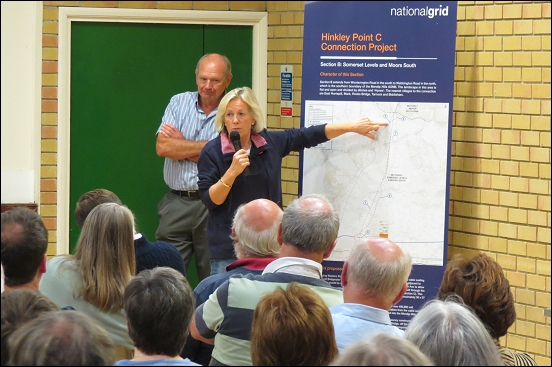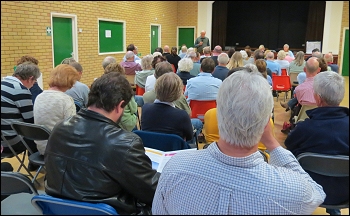 Dozens of concerned residents in the Burnham-On-Sea area last night demanded National Grid bury its planned 400,000 volt power line under the Bristol Channel instead of building huge pylons across the Somerset Levels.
Dozens of concerned residents in the Burnham-On-Sea area last night demanded National Grid bury its planned 400,000 volt power line under the Bristol Channel instead of building huge pylons across the Somerset Levels.
That was the conclusion at the end of a heated public debate held in the village of Mark on Sunday evening, which was attended by over 80 local people, including MP Tessa Munt and Conservative parliamentary candidate James Heappey.
National Grid has proposed that its 34-mile power connection will stretch between Hinkley Point and run past several villages near Burnham-On-Sea to Avonmouth.
More than five miles of the route will run through the Mendip Hills where the power line will be buried underground, but local residents fear the overhead pylons would blot the landscape, cause health issues and hit house prices.
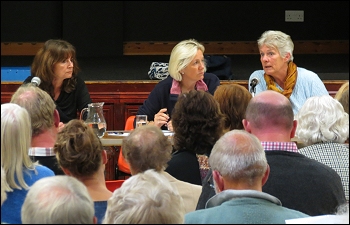 Sunday’s meeting was held mid-way through National Grid’s final round of consultation, where the public can have their say about the controversial plans.
Sunday’s meeting was held mid-way through National Grid’s final round of consultation, where the public can have their say about the controversial plans.
Maggie Gregory, from Pylon-Moor-Pressure, said: “National Grid say a sub-sea connection is too expensive and have dismissed it just as quickly as they did when considering installing the pylons along the M5 corridor in 2007, even though it was shown that just 37 properties would have been affected. When you consider the impact that this current route would have to the Somerset Levels it’s just terrible. These would be industrial structures in the middle of the countryside.”
And local resident Jane Walker added: “We should not have these pylons here – they would be hideous and would destroy a beautiful area. We need a united front against National Grid.”
She added that she feels the numerous rounds of public consultation have been held by National Grid as a ploy to “dilute public interest in the scheme and reduce the number of people voicing their opposition.”
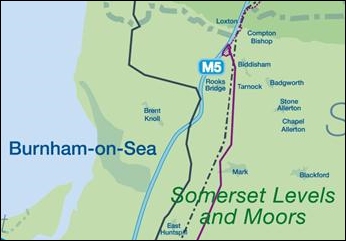 Another local resident, Bruce Penrose, added: “Don’t let National Grid divide us – we should all be saying ‘no, it’s got to be sub-sea all the way.'”
Another local resident, Bruce Penrose, added: “Don’t let National Grid divide us – we should all be saying ‘no, it’s got to be sub-sea all the way.'”
He urged residents to begin a letter-writing campaign to National Grid’s Chief Executive, explaining: “He needs to receive thousands of letters to feel the pain just as we do.”
He went on to question the real costs of the sub-sea power route. Eileen Corkish, from Mark Parish Council, said the power firm had said the overground route would cost around £13million, while the underground cost had varied from £270million to £78million most recently. She added that the sub-sea route would cost £1.3billion.
Tessa Munt told the meeting she feels the “sub-sea costs have never been backed up with evidence from National Grid” and she added that she would like to see this in more detail.
Local resident Mike Taylor added: “We must be pushing for undergrounding, but I feel the decision is all about profit – National Grid just want the cheapest route possible. It’s just sheer greed.”
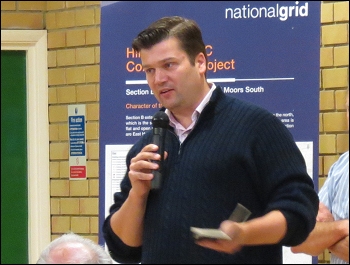 James Heappey, right, urged residents to lobby the government on the matter. “The only way we’ll change National Grid’s mind here is by getting a change to the policy at a national level.”
James Heappey, right, urged residents to lobby the government on the matter. “The only way we’ll change National Grid’s mind here is by getting a change to the policy at a national level.”
He explained: “I would urge residents to support Liam Fox’s amendment to the Energy Bill which currently is awaiting a second reading in the Lords. The amendment would change the Holford Rules that give National Grid a very effective umbrella to shield them from whatever criticisms arise during consultation. Those rules are, in my opinion, outdated.”
“The Holford Rules guide their decision-making on the routing of transmission lines. Letters to Ed Davey, Michael Fallon and Owen Patterson are very important as there are all sorts of hurdles at which Dr Fox’s amendment could fall. If the law is not changed through Parliament, then it will require one of these ministers to issue a policy statement that influences the Holcroft Rules to the same effect.”
Another resident raised concerns about the health impacts of the proposed 400,000 volt pylons given their close proximity to homes. Eileen Corkish responded that National Grid “had been totally tied up in knots” when addressing health questions during its latest consultation session and that more clarity is needed.
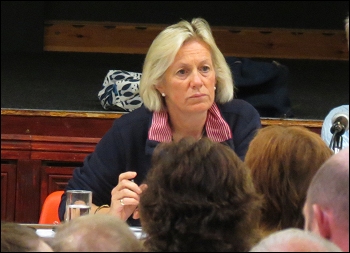 Tessa Munt quoted examples of cases where adverse health affects had been found between pylons and leukemia in Iran and Alzheimer’s in Switzerland.
Tessa Munt quoted examples of cases where adverse health affects had been found between pylons and leukemia in Iran and Alzheimer’s in Switzerland.
Pylon campaigners also said that the vague wording of National Grid’s documents and diagrams showing the relative height of the T-pylon against the old-style lattice pylon that National Grid uses for such a high-voltage line means that many residents believe that the T-pylon is lower than the existing Western Power line and so they are no longer concerned about the effect on visual amenity.
Maggie Gregory from Pylon-Moor-Pressure said: “This is not the case. The T-pylon is 9 metres higher than the Western Power line. I have pointed out to National Grid that their consultation material is unclear and asked them to restart this important exercise. They need to issue revised material which clearly demonstrates the scale of the T-pylon in relation to the existing line and in relation to the enormous lattice pylon which they would otherwise use. That may be as high as 50 metres. Only then can people make a judgement on the scale of this infrastructure. National Grid has refused to do so.”
Residents also queried during the meeting whether alternative routes are still being considered by National Grid and also discussed concerns regarding construction traffic routes and additional scrutiny of National Grid.
Tessa Munt and James Heappey both agreed with residents that a sub-sea route is the only palatable option.
The MP told Burnham-On-Sea.com afterwards: “I’m pleased to see local people are fired-up over this issue. The meeting showed that the sub-sea route is the route preferred. National Grid have been ‘tin-eared’ so far – they have been in transmit mode, not receive mode – and they need to listen to the feedback on this very important issue.”
Residents were urged to send their feedback to National Grid during its consultation period, which lasts until the end of October.

